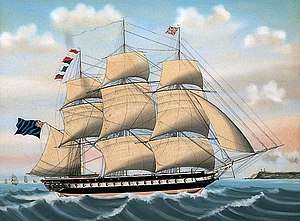HMS Arethusa (1817)
HMS Arethusa was a 46-gun Leda-class fifth-rate frigate built for the Royal Navy during the 1810s. The ship was never commissioned and was converted into a lazarette (quarantine ship) in 1836. She was renamed HMS Bacchus in 1844 and was further converted into a coal hulk in 1851–52. The ship was sold for scrap in 1883.
 Arethusa | |
| History | |
|---|---|
| Name: | Arethusa |
| Namesake: | Arethusa |
| Ordered: | 22 November 1812 |
| Builder: | Pembroke Dockyard |
| Laid down: | February 1815 |
| Launched: | 27 July 1817 |
| Completed: | 29 September 1817 |
| Commissioned: | Never |
| Renamed: | As Bacchus, 12 March 1844 |
| Reclassified: |
|
| Fate: | Sold for scrap, 14 August 1883 |
| General characteristics | |
| Class and type: | Leda-class frigate |
| Tons burthen: | 1084 60/94 bm |
| Length: | |
| Beam: | 40 ft 1 in (12.2 m) |
| Draught: | 14 ft 7 in (4.4 m) |
| Depth: | 12 ft 9 in (3.9 m) |
| Sail plan: | Full-rigged ship |
| Complement: | 315 |
| Armament: |
|
Description
Arethusa had a length at the gundeck of 150 feet 11 inches (46.0 m) and 126 feet 11 inches (38.7 m) at the keel. She had a beam of 40 feet 1 inch (12.2 m), a draught of 14 feet 7 inches (4.4 m) and a depth of hold of 12 feet 9 inches (3.9 m). The ship's tonnage was 1084 60⁄94 tons burthen.[1] The Leda-class frigates were armed with twenty-eight 18-pounder cannon on her gundeck, fourteen 32-pounder carronades on her quarterdeck and a pair of 9-pounder cannon and two more 32-pounder carronades in forecastle. The ship had a crew of 315 officers and ratings.[2]
Construction and career
Arethusa, the fourth ship of her name to serve in the Royal Navy,[3] was ordered on 22 November 1812, laid down in February 1815 at Pembroke Dockyard, Wales, and launched on 29 July 1817.[2] She sailed for Plymouth Dockyard on 21 August 1817 and was completed for ordinary on 27 September at the cost of £25,923.[4] The ship was never on active duty and was converted for service as a lazarette for Liverpool in April–June 1836. Arethusa was renamed HMS Bacchus on 12 March 1844[1] to release her name for the large frigate being built[5] and converted into a coal hulk in 1851–52. The ship was sold to Castle & Sons for £1,450 on 14 August 1883 to be broken up.[4]
Notes
- Winfield 2008, p. 687
- Winfield & Lyon, p. 107
- Colledge, p. 19
- Winfield 2014, p. 577
- Phillips, p. 57
References
- Colledge, J. J.; Warlow, Ben (2006) [1969]. Ships of the Royal Navy: The Complete Record of all Fighting Ships of the Royal Navy (Rev. ed.). London: Chatham Publishing. ISBN 978-1-86176-281-8.
- Phillips, Lawrie; Lieutenant Commander (2014). Pembroke Dockyard and the Old Navy: A Bicentennial History. Stroud, Gloucestershire, UK: The History Press. ISBN 978-0-7509-5214-9.
- Winfield, Rif (2008). British Warships in the Age of Sail, 1793-1817: Design, Construction, Careers and Fates (epub). Barnsley, UK: Seaforth. ISBN 1-84415-700-8.
- Winfield, Rif (2014). British Warships in the Age of Sail, 1817-1863 (epub). Barnsley, UK: Seaforth. ISBN 978-1-47383-743-0.
- Winfield, R.; Lyon, D. (2004). The Sail and Steam Navy List: All the Ships of the Royal Navy 1815–1889. London: Chatham Publishing. ISBN 978-1-86176-032-6.